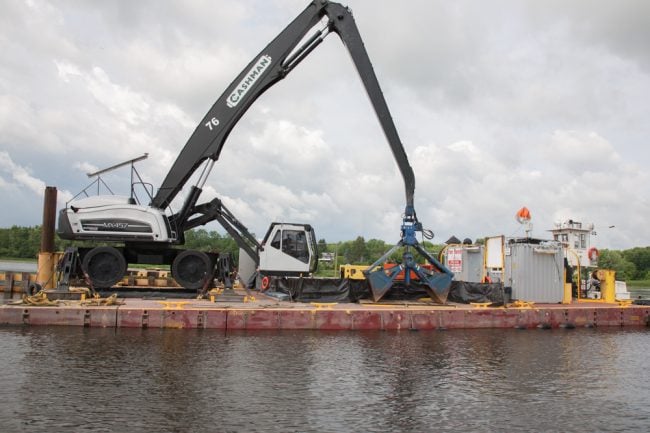Demand More from EPA — We Must Be Protected from PCBs
The EPA Five-Year Review of Hudson River PCB Superfund site is underway. Riverkeeper continues to call for EPA to do more to ensure that it is an open, transparent, and scientifically reliable assessment. These concerns are shared by both federal and state agencies (the Attorney General’s Office and DEC).
On November 14, Basil Seggos, Commissioner of the New York State Department of Environmental Conservation’s (DEC) wrote to EPA demanding that over 1,400 additional sediment samples be collected in the river to enable accurate assessment of the effectiveness of the past 6 years of dredging. As DEC Commissioner Seggos concluded: “Unfortunately, EPA’s unwillingness to require GE to perform adequate sediment sampling undermines the five-year review process to determine the protectiveness of the remedy, and it makes it difficult to show that the remedy is meeting the goals set by the ROD [Record of Decision].”
We cannot allow EPA and GE off the hook. GE must be held responsible until the cleanup is complete—the only way the river can once again be a positive resource for our families, communities, and economy.
JOIN US on in Albany on Wednesday, November 30th, from 7-9pm to tell EPA that they must do more!
The Five-Year Review require must require EPA to do at least the following:
- Take more sediment samples
As DEC pointed out, a lot more samples need to be taken of the sediment to (1) determine if the dredging will meet the goals of the cleanup, (2) determine if the cleanup is protective, as part of the Five Year Review process, and (3) to determine what additional locations need to be removed if the cleanup is failing to meet its goals.Additionally, EPA should include specific samples of the areas immediately adjacent to the dredged locations, as these areas are likely the most heavily contaminated, having the largest impact on recontamination
- Take more frequent sediment samples
GE is required to take sediment samples at least every 3 years, but EPA’s current plan wrongfully only requires sampling every 5 years.Additionally, because some goals of the cleanup are to be met within 5 years of the dredging, it is critical to get information before the five years is up.
- Sample sediments on a pool-by-pool basis*
Along with taking more and more frequent samples, EPA must change the sampling to focus on contaminated pools in the river (beyond a “river section” basis) to better align with the State’s fish consumption advisory data.The 40-mile cleanup was divided into three “river sections,” meaning that the planned sediment sampling plan will result in less than ten samples for every mile. Instead, EPA must require samples to be taken in specific local reaches of the river between dams, called “pools,” where the fish tend to stay.
- Undertake a comprehensive fish consumption survey
Now that the ordered dredging is complete, EPA is hanging its hat on the fish consumption advisory as the only way to protect us from PCBs. But because New York State’s fish consumption advisory unfortunately fail to prevent people from eating and feeding their families toxic fish, it is critical to know just how many people are eating Hudson River fish and in what locations. - Issue a “not protective” Five Year Review determination
As Riverkeeper, and government agencies — DEC, NOAA, USFWS, and the New York State Attorney General — have all pointed out, the data indicates that the cleanup performed by GE is “not protective” of human health and the environment. The non-dredged sediment remains more contaminated, it will take longer for the PCBs to leave the river, and the fish remain toxic for human consumption, just to name a few. Therefore, EPA cannot reasonably conclude as part of the Five-Year Review that the cleanup is or will be protective. - Require GE to immediately undertake more dredging of PCBs in the Hudson
Additional dredging, and supporting studies, if needed, must be completed immediately, and within 5 years at the longest. We’ve waited too long for the recovery of our river and our river-based economy, there is no justification to require us to wait any longer in the face of this clear evidence.
We need your support to ensure that EPA will not let GE continue to endanger our lives, and the lives of future generations.
Tell EPA that you will not accept anything less than a determination of “not protective”!
Hudson River PCB Superfund Meeting in Albany
WHEN: November 30, 2016: 7:00PM-9:00PM
WHERE: Albany Marriott, 189 Wolf Road, Albany, NY 12205 (map)
More information here.
*For our full critique of EPA’s sediment sampling plan, please check out our letter to EPA.
Background:
The entire Hudson River, from the former GE plant in Hudson Falls to the Battery in New York City is a federal Superfund site because GE’s dumped of millions of pounds of PCBs into the river prior to the 1970s. In 2002, EPA and GE agreed that GE would dredge approximately 65% of the then-known PCBs north of the Federal Dam at Troy. From 2009 to 2015, GE dredged over 2.65 million cubic yards of sediment from the Hudson, but there is much more PCBs in the river than was initially thought.
EPA is required to review the Hudson River site every five years because the dredging in the Upper Hudson River left behind PCBs. In the “Five-Year Review,” EPA must analyze the data to ensure that the selected remedy for the river is “protective of human health and the environment.” If it is not, EPA must take steps to ensure the protectiveness of the remedy.
EPA’s next Five Year Review is due in April 2017.


